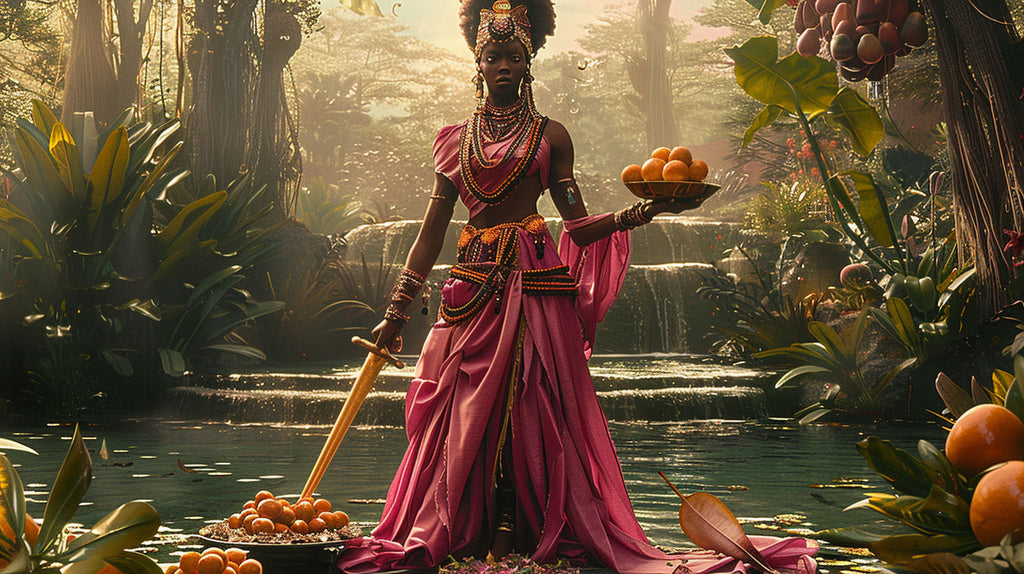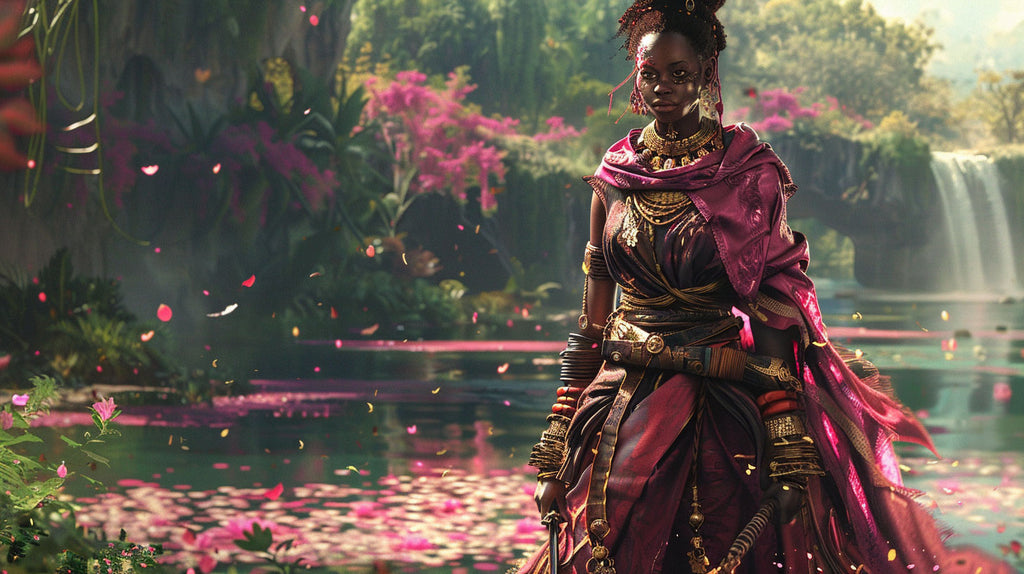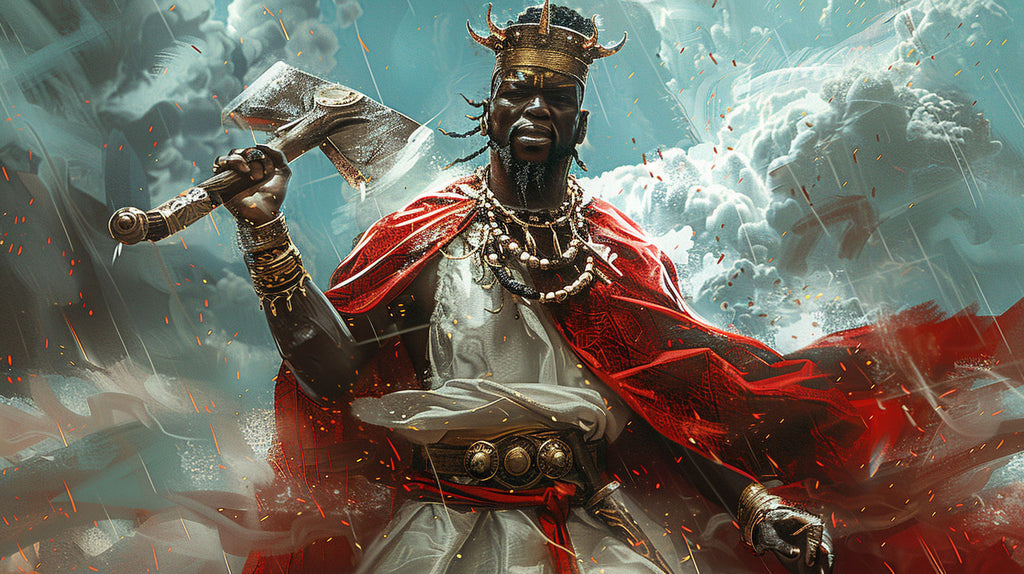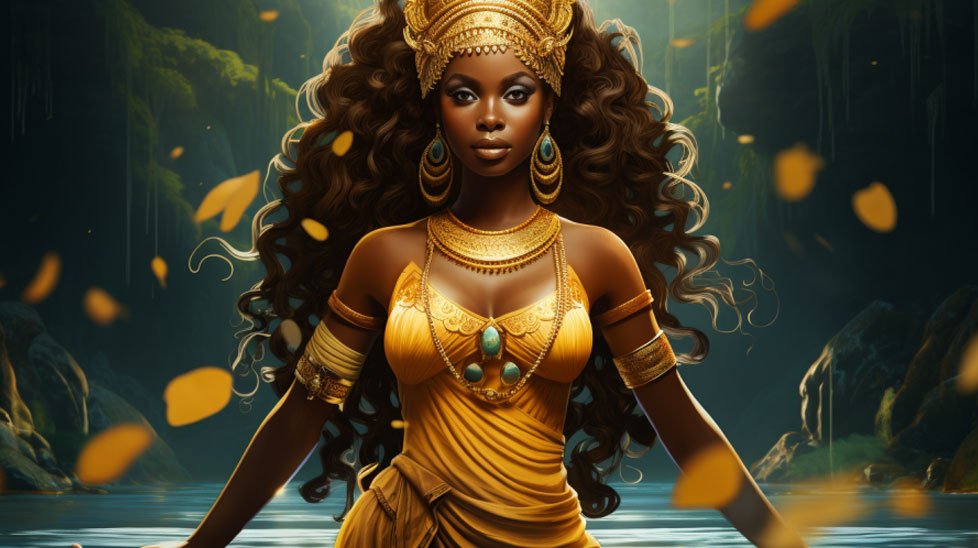Oba: The Orisha of Protection, Marriage & Fidelity in Yoruba, Santeria & Candomble
Gil SantosShare

In the Yoruba faith, Obá Orisha is highly respected for representing the essence of perseverance and loyalty. This powerful entity, often associated with rivers and the warrior spirit, plays a crucial role in the spiritual lives of its followers. The Yoruba people, originating from what is now Nigeria and its surrounding regions, have long celebrated Obá Orisha through rituals, songs, and stories that highlight her strength and resilience.
Grasping the concept of Obá Orisha opens a window into the practices of Yoruba religion and casts light on the intricate mythology that forms the cultural foundation of its followers. This introduction aims to demystify the significance of Obá Orisha for those unfamiliar with this captivating figure in Yoruba mythology.
Key Takeaways
- Understanding Obá Orisha is crucial for those interested in Yoruba religion and mythology, as it provides insights into the diverse pantheon of deities and their interconnected roles within the spiritual realm.
- Learning about the variants of Oba's name and how they reflect her attributes can deepen one's appreciation for the complexity and richness of Yoruba religious practices and beliefs.
- Exploring worship practices in Ogbomosho offers a glimpse into the localized expressions of faith and how they adapt to different cultural contexts, highlighting the dynamic nature of Yoruba spirituality.
- The symbolism of Oba's ear serves as a powerful reminder of the themes of sacrifice, loyalty, and the consequences of rivalry among the Orishas, teaching valuable moral lessons to devotees.
- Recognizing the relationship between Obá and other Orishas is essential for understanding the intricate web of myths, stories, and power dynamics that define the Yoruba pantheon.
- Elemental attributes and colors associated with Obá, as well as sacred sites and offerings, provide practical insights for practitioners and followers on how to connect with and honor this Orisha in their daily lives.
Obá Orisha Overview
Warrior Spirit
Obá stands as a formidable warrior among the orisha in the Yoruba religion. She embodies courage and strength, traits that have made her a revered figure. Her prowess in battle underscores her role as a protector, safeguarding her followers from harm.

Her attributes extend beyond mere physical might. Obá is also associated with fidelity and the complexities of love and betrayal. This duality makes her a deeply nuanced deity, reflecting the multifaceted nature of human emotions and relationships.
Powers and Domain
As a powerful orisha, Oba's domain encompasses protection, marriage, and fidelity, making her an essential figure for those seeking guidance in these areas. Her powers are deeply rooted in the natural world, allowing her to wield influence over rivers and fresh waters, which are considered to be her sacred spaces.
Followers believe that Oba can offer protection against adversaries, heal broken relationships, and guide individuals towards making wise decisions in their personal lives. Her narratives often highlight themes of sacrifice, resilience, and the importance of wisdom, teaching valuable lessons to those who honor her.
Through rituals and offerings, devotees can connect with Oba, seeking her blessings for strength, courage, and support in navigating life's challenges.
Mythological Origins
The lore surrounding Obá traces back to ancient Yoruba mythology, where she is often depicted as one of the wives of Shango, the god of thunder and lightning. Her stories are rich with themes of love, jealousy, and sacrifice. One notable tale recounts how Obá cut off her ear to cook it in a soup for Shango, hoping to win his favor over her rival Oshun. This act, however, led to her ridicule rather than admiration.
These mythological tales not only illustrate Obá's character but also impart moral lessons on loyalty, the pitfalls of envy, and the importance of wisdom over brute strength.
Cultural Impact
Obá's influence extends far beyond the realm of mythology. She plays a vital role in contemporary Yoruba religious practices, embodying principles that resonate with practitioners and communities alike.
Her festivals are occasions for vibrant celebrations, marked by rituals that honor her spirit and seek her blessings. These events reinforce communal bonds and provide an avenue for cultural expression.
Moreover, Obá's stories continue to inspire discussions around gender roles and power dynamics within relationships. They offer valuable insights into navigating life's challenges with grace and resilience.
Variants of Orisha Oba in religions and countries
Orisha Oba has transcended its origins to become a figure of veneration in various countries and religious practices. Initially rooted in the Yoruba culture of West Africa, particularly in present-day Nigeria and Benin, Oba's worship has spread across the Atlantic through the transatlantic slave trade, finding a home in the Americas.

In these new lands, Oba has been syncretized with Catholic saints and other deities from different African traditions, weaving together a complex and vibrant mosaic of beliefs and practices. This syncretism is most evident in countries like Brazil, Cuba, and Haiti, where African diasporic religions such as Candomblé, Santería (also known as Lukumi), and Vodou have embraced Oba in their pantheons, albeit under different names and attributes.
The variations of Orisha Oba across these religions reflect the adaptability and resilience of African spiritual traditions when faced with the forces of colonialism and diaspora:
- In Brazil's Candomblé, Oba is often associated with domestic spheres and marital fidelity, embodying the struggles and perseverance of women.
- In Cuba's Santería, she is syncretized with Santa Rita de Casia, reflecting aspects of suffering and triumph over difficulties.
- In Haitian Vodou, Oba's characteristics and stories are interwoven with those of other loas, showcasing her warrior aspects and her role as a fierce protector
These adaptations not only highlight the fluidity of spiritual practices but also underscore the cultural exchanges that occur within diasporic communities.
|
Country/Region |
Religion |
Variant Name |
Attributes |
Syncretization |
|---|---|---|---|---|
|
Brazil |
Candomblé |
Oba |
Domesticity, marital fidelity |
None specific |
|
Cuba |
Santería |
Oba/Santa Rita de Casia |
Triumph over difficulties |
Catholic Saint Rita de |
Symbolism of Oba's Ear
Devotional Act
The story of Obá involves a profound act of devotion. She cut off her own ear to prove her loyalty and love. This act is not just a tale of sacrifice but also a deep symbol within the faith.
Obá's decision to mutilate herself was driven by her desire to please her husband, Shango. Her actions, though extreme, highlight the lengths she was willing to go for love and fidelity. This story underscores the importance of sacrifice in demonstrating devotion not only to the deities but also within personal relationships among followers.
Symbolic Interpretation
Interpretations of Obá's action vary widely among her worshippers. Some see it as an ultimate expression of loyalty, while others view it as a cautionary tale about the dangers of blind devotion.
Regardless of the perspective, this narrative has significantly impacted how Obá is perceived by her followers. It positions her as an orisha who values loyalty above all else, making her a beacon for those seeking strength in their own commitments. The symbolism of Obá’s ear serves as a reminder that true devotion may require personal sacrifices.
Influence on Worship
The story of Obá's ear has deeply influenced worship practices within the Yoruba religion. Rituals and offerings made to Obá often involve symbols representing sacrifice and loyalty. These can include items that signify giving up something valuable for a greater purpose.
Followers are reminded through these practices that their relationship with the divine requires genuine commitment and sometimes personal sacrifices. This mirrors the earlier discussion on worship practices in Ogbomosho, where devotees engage in acts symbolizing their dedication to their faith.
Relationship with Other Orishas
Shango Bond
Obá, in her essence, shares a complex bond with Shango, the deity of thunder and lightning. As his third wife, she embodies loyalty and fierce devotion. Their union is not just a marital connection but a strategic alliance within the celestial hierarchy.

Shango values Obá for her warrior spirit and her readiness to defend their realm. Together, they present an indomitable force against adversaries. However, this relationship also places Obá in direct competition with Shango's other wives, notably Oshun.
Rivalry with Oshun
The rivalry between Obá and Oshun is legendary within Yoruba mythology. Stemming from their mutual desire for Shango's affection, this conflict highlights deep emotional intricacies among the orishas.

Oshun, known for her beauty and charm, often overshadows Obá in matters of love and attention from Shango. This rivalry extends beyond mere jealousy; it underlines the contrasting aspects of femininity and power represented by each goddess.
The stories revolving around their competition serve as metaphors for human emotions and social dynamics.
Guardian Role
Beyond her relationships marked by love and rivalry, Obá serves as a guardian spirit to many. Her protective nature is evident in how she interacts with other deities and humans alike.
She embodies the warrior aspect of femininity — strong, determined, and fiercely independent. This role as protector extends to those who seek comfort in times of need or guidance during turmoil.
Followers believe that invoking Obá’s spirit can provide safety against harm and lead one towards self-realization.
Daughter’s Comfort
Interestingly, Obá is also revered as a mother figure by some lesser-known orishas. She offers comfort and guidance to these spirits, nurturing their abilities to fulfill their divine roles.
Her maternal instinct further solidifies her position within the pantheon as a deity of both war and compassion. This duality makes her particularly relatable to human followers who see in her the embodiment of strength through adversity.
Elemental Attributes and Colors
Water Significance
Water plays a central role in Obá's elemental attributes. It symbolizes her deep emotional strength and her ability to cleanse and heal. Followers often use water in rituals to connect with Obá, offering it as a sign of purity and devotion.
Rituals by the riverbank are common, where devotees gather to pay homage. They believe these waters carry their prayers directly to Obá.
Earth Connection
Obá is also deeply connected to the earth, reflecting her grounded nature and resilience. This element underscores her role as a protector who stands firm against adversity.
In ceremonies, participants use soil and rocks in offerings, symbolizing stability and endurance. These elements remind worshippers of Obá's unwavering support.
Warrior Colors
The colors associated with Obá—red and maroon—highlight her warrior aspect. Red signifies the blood of life and battles fought; maroon represents the earth's richness and fertility.
Devotees wear these colors during festivals to honor Obá's fighting spirit. They also decorate altars with cloths of these hues, creating a vibrant space for worship.
Ritual Uses
The elemental attributes and colors tied to Obá find their way into various parts of Yoruba religious practices. From spells cast for protection to offerings made in gratitude, each ritual element holds significance.
- Water is used in cleansing ceremonies.
- Soil from sacred lands is incorporated into protective amulets.
- Red candles are lit to invoke strength during challenging times.
These practices demonstrate the deep connection between Obá’s followers and the natural world she embodies.
Symbolic Meanings
Beyond their use in rituals, Obá's elements and colors carry symbolic meanings that enrich Yoruba mythology. Water reflects adaptability; earth denotes resilience; red signals courage; maroon suggests nurturing care.
These symbols offer guidance for daily living, encouraging individuals to embody Obá’s qualities of strength, protection, and healing.
Sacred Sites and Offerings
Sacred Sites
Obá's followers find solace and spiritual connection in various sacred sites. Rivers, as the embodiment of Obá's essence, hold a special place in the hearts of her devotees. These natural water bodies are not just geographical features but are considered living entities that house the spirit of Obá.
Forests, too, play a crucial role in her worship. They provide a secluded space for rituals and meditations, allowing individuals to connect with nature and the divine.
Temples dedicated to Obá offer a more structured environment for worship. These sacred spaces are adorned with symbols and colors significant to Obá, reflecting her elemental attributes. Each site, be it natural or constructed, serves as a conduit for communication with the deity, facilitating a deeper understanding of her teachings.
Offerings
The act of giving offerings is central to the worship of Obá. This practice symbolizes respect and devotion, bridging the gap between the physical and spiritual realms. Food offerings are common; they often include items that are believed to be favored by Obá, such as fruits and grains.
These offerings are placed on altars at home or at sacred sites, signifying sustenance for both the deity and her followers.
Objects like beads, fabrics, and other artifacts also hold significance when offered to Obá. They represent various aspects of life—love, protection, prosperity—and their offering is an act of faith in Obá's power to influence these areas positively.
Rituals accompany these offerings; they might involve prayers, songs, or dances that honor Obá's presence.
Connection
The intricate relationship between sacred sites and offerings underscores a fundamental aspect of Obá’s worship: the desire for communion with the divine. Devotees visit these holy places not merely as tourists but as pilgrims seeking guidance and blessings from Obá. The act of making an offering is deeply personal—it’s an expression of gratitude and hope.
This dynamic fosters a strong bond between devotees and their deity. It allows them to express their fears, desires, and thanks in a tangible form. Moreover, it reinforces the community's unity as individuals gather at these sites or partake in collective rituals that celebrate their shared beliefs.
Iconography and Devotees
Common Symbols
Obá is often depicted with vibrant symbols that reflect her essence. Art and religious items frequently showcase her with a sword, signifying her warrior spirit. Rivers are a common motif, symbolizing her domain and the life-giving qualities of water. These symbols not only represent Obá's power but also her role as a protector and nurturer.
In iconography, colors hold deep meanings. Obá is associated with deep reds and burgundies, hues that echo her connection to love, passion, and the complexities of femininity. This color palette helps devotees connect visually and spiritually with her energy.
Devotee Demographics
Obá's followers come from diverse backgrounds. Many are drawn to her strength as a warrior goddess who fiercely protects her children. Women often feel a special connection to Obá due to her stories of overcoming betrayal and finding empowerment. Her devotees include those seeking guidance in matters of love, fidelity, and personal growth.
Interestingly, Obá's worship is not limited by gender or age. Men also find solace in her strength, seeking blessings for protection and prosperity. Families pray to Obá for unity and harmony within their homes.
Personal Devotion
Devotion to Obá goes beyond mere admiration; it involves deeply personal experiences. Followers often share stories of how Obá guided them through difficult times or intervened miraculously in desperate situations. Such testimonies highlight the intimate bond between the deity and her devotees.
Rituals and offerings form an essential part of this devotion. They range from simple acts of prayer to elaborate ceremonies designed to honor Obá and seek her favor. Through these practices, followers express their gratitude, love, and respect for the orisha.
Summary
The exploration of Obá Orisha reveals a rich tapestry of spiritual beliefs, practices, and symbolism deeply rooted in the traditions of the Yoruba people. From the overview of Obá's place within the Yoruba pantheon to the detailed examination of worship practices, elemental attributes, sacred sites, and interconnected myths, this article has provided a comprehensive look at a deity whose influence extends beyond the confines of traditional worship into the broader realms of Santería and global spirituality. The discussion on Obá's relationship with other Orishas, alongside the exploration of her iconography and devotees, underscores the complexity and depth of Yoruba religious culture.
This synthesis invites readers to reflect on the enduring power of myth, tradition, and spirituality in shaping human understanding and social cohesion. It also encourages further exploration into the rich world of Yoruba religion and its diaspora manifestations. For those intrigued by the intersections of culture, history, and spirituality, delving deeper into studies on Obá Orisha and related deities offers a pathway to greater insight and appreciation.
Frequently Asked Questions
What is Obá Orisha?
Obá Orisha is a deity in the Yoruba religion, often associated with marriage, loyalty, and rivers. She is known for her intense devotion and tragic narrative involving her ear.
How does Obá relate to other Orishas?
Obá shares complex relationships with other Orishas, notably being one of the wives of Shango. Her interactions underscore themes of rivalry, love, and sacrifice within the pantheon.
What are the elemental attributes and colors associated with Obá?
Obá's elemental attribute is water, reflecting her connection to rivers. Her colors are typically pink and maroon, symbolizing love, passion, and resilience.
Can you explain the symbolism of Obá's ear?
The symbolism of Obá's ear relates to a myth where she cuts off her ear in an attempt to win back her husband's favor. It signifies sacrifice, but also misunderstanding and loss.
What are typical offerings made to Obá?
Offerings to Obá include sweet treats, fruits, especially oranges, and items that reflect her martial prowess and royal status like swords or mirrors.
How does Santería incorporate Obá?
In Santería, a religion that blends Yoruba beliefs with Catholicism, Obá is revered as a powerful Orisha. Her practices involve rituals and offerings specific to this faith's interpretation of her attributes and stories.
What significance do sacred sites hold for Obá worshippers?
Sacred sites for Obá worshippers often include riverbanks or bodies of water believed to be under her protection. These sites are places for prayer, offerings, and ceremonies dedicated to honoring her essence and seeking her blessings.
About the Author
Gil Santos
With over 20 years of experience in various narrative mediums, Gil Santos is the singular mind behind Culture Bay. His journey began as a lyricist and web developer, later expanding into crafting dynamic conference presentations and engaging YouTube sketches. This diverse background has allowed him to hone his storytelling skills across different fields. Santos' lifelong passion for sci-fi and fantasy, combined with his knack for interactive storytelling, culminate in Culture Bay - a fusion of innovative ideas and engaging narratives intended for all to enjoy.
